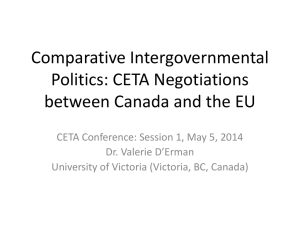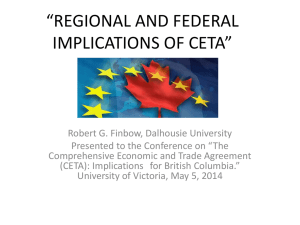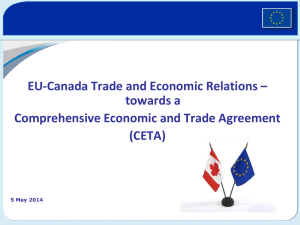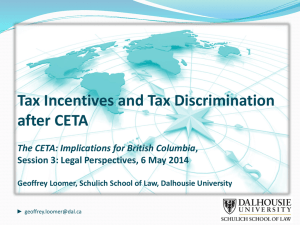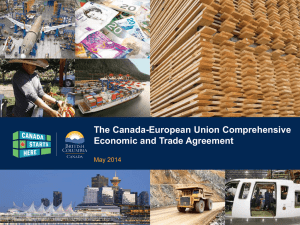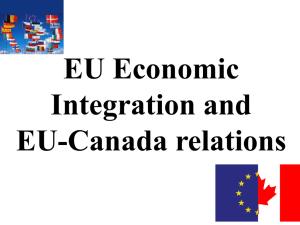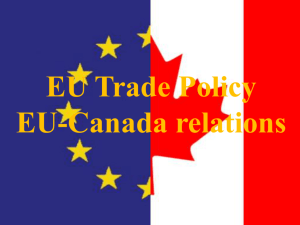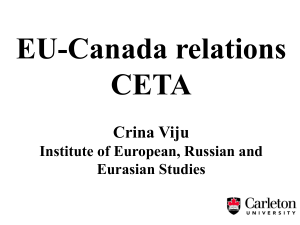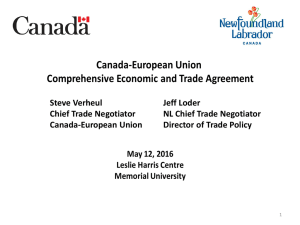What`s in CETA? What we know so far and potential
advertisement
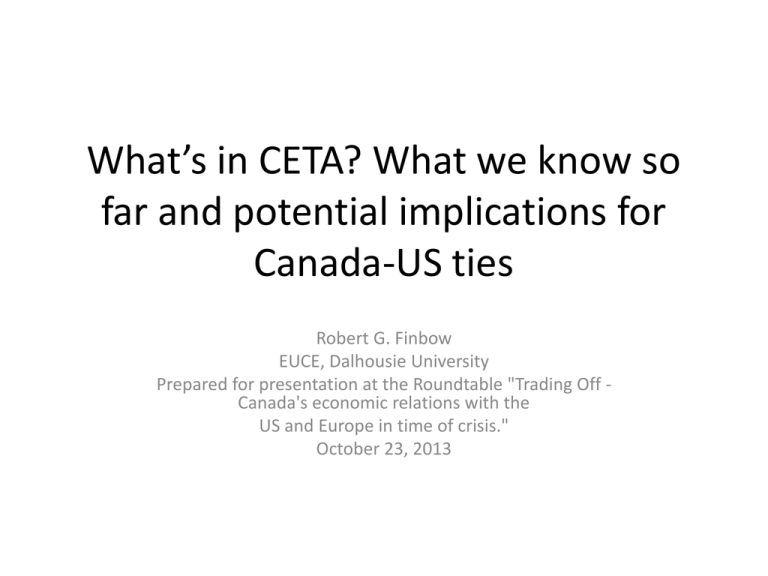
What’s in CETA? What we know so far and potential implications for Canada-US ties Robert G. Finbow EUCE, Dalhousie University Prepared for presentation at the Roundtable "Trading Off Canada's economic relations with the US and Europe in time of crisis." October 23, 2013 CETA as a “next generation” FTA “enhanced economic partnership agreement” EU’s interest in an FTA with the US? CETA could set precedent new issues to catch up with changes and challenges of global economy; complex supply chains, IP, virtual goods. trade in services and intellectual property protection “beyond the border” issues involve domestic or sub-national issues in a federation like Canada. Conflicting assessments of economic benefits – did Canada gain as much as the EU? Liberalization of Goods Trade • Eliminating duties – rapidly removing 98% of tariffs (though many are already low) • Elimination of technical barriers to trade • Industrial tariffs – lower costs to buyers • Agricultural tariffs – gradual removal on 92%- 94% of products • No end to EU agricultural subsidies, even in some affected areas like cheese production • Fish (raw and processed) to be opened up • Quotas remain in dairy, meats but access increased • Potential gains in advanced goods exports? aerospace and auto-parts in Ontario and Quebec, agricultural machinery in Saskatchewan, extractive machinery in NL, biomedical in NS Trade in Goods http://ec.europa.eu/trade/policy/countries-and-regions/countries/canada/ http://www.actionplan.gc.ca/sites/default/files/pdfs/final_sectors_content-eng_v11.pdf Merchandise Trade http://www.parl.gc.ca/content/lop/researchpublications/2010-86-e.htm Liberalization of services • negative list" approach: • services in all sectors are granted access and nondiscriminatory treatment except for specific exceptions listed in the CETA • Covered areas include: • Financial services • telecommunications, • energy • maritime transport • E-services: e-books, e-payments, e-recruitment services Trade in Services http://ec.europa.eu/trade/policy/countries-and-regions/countries/canada/ Services Exchanged http://www.parl.gc.ca/content/lop/researchpublications/2010-86-e.htm Technical barriers to trade • • • • • • • • • Technical regulations testing and certification requirements. often establish necessary safety measures, Can become a barrier to trade if they are too burdensome or discriminatory Follows WTO Agreement on Technical Barriers Promotes mutual recognition of standards to facilitate trade Creates mechanisms so regulatory bodies can recognize each others product tests and certifications to reduce costs and duplication Public input and cooperation between standards bodies Coordination of sanitary and phytosanitary measures Professional Mobility • Mutual recognition of qualifications – gradual coordination of licensing for professions such as architects, engineers, and accountants • Temporary Movement – rights for firms to move employees to facilitate trade in services and investment as well as maintenance and monitoring for exported equipment Intellectual property • Canada moving closer to EU, WTO standards • Covers IP, trademarks, designs and copyrights • Important in pharmaceuticals where at least 2 years patent protection extension granted • Data protection keeps Canadian model • Concerns re price increases from patent extension • Geographic indicators – respect for trademarks on local and speciality products Public procurement • Access for both parties at all levels of government and all agencies, departments • Limited declared exceptions • Transparency in tenders via new electronic systems for bidders • Thresholds for local preferences raised • $315,538 for goods and services • $631,077 for procurement by utilities • $7.8 million for construction services • Thresholds: too high or too low? • important sectors, such as education and health services may be excluded Investment provisions • non-discrimination, a fair and equitable treatment and appropriate compensation for expropriation • Elimination of barriers and clarification of legal requirements • Raising threshold for review of takeovers • “Modern” disputes settlement procedures based on mediation and penalties as a last resort • Will it contain guarantees against frivolous use to secure penalty payments for speculative losses? Investment Relationship http://ec.europa.eu/trade/policy/countries-and-regions/countries/canada/ Investment Relationship http://www.parl.gc.ca/content/lop/researchpublications/2010-86-e.htm Dispute settlement mechanism • Comprehensive across the agreement • Addresses disagreements on interpretation and enactment of CETA • Arbitration and mediation provisions • Last resort penalties • Investor rights as yet unclear but likely include the ability to proceed in closed tribunals and in court against losses related to violations of CETA • Will disputes system limit regulatory power in areas like the environment? Or other areas of public concern? CETA: Complicating the North American Relationship? • Bilateral talks with Canada could set precedents for US-EU negotiations • But provisions could differ • Canada: movement towards EU friendly regulatory standards could conflict with NAFTA collaborations with the US? • EU will seek similar concession in US deal, but prospects complicated by fraught US political situation Automotive Sector Controversies • Automotive rules of origin: EU sought as much as 60% Canadian content • Canadian co-production with US firms makes this difficult to attain • Compromise: all vehicles with 50% Canadian content are now unrestricted (could aid US exports) • Vehicles over 20% get larger quota of 100,000 • Canada will recognise some EU car standards and will considers others in future • Easier for EU to export cars to Canada • Could complicate Canada-US coordination on standards Possible complications for US companies • Will CETA GIs force US suppliers to re-label goods for export to Canada? • US exporters will need to be aware of rules of origin requirements and be able to provide proof of origin when need be • Regulatory standards coordination with EU could have impact on US firms • New regulatory approval procedures or changed standards could alter Canada-US regulatory practice • Some US firms with Canadian or EU subsidiaries could benefit from liberalization How will Canada fare? • Government cites the access gained to the world's largest economy • 28 member states, 500 million people and annual economic activity of $17 trillion • Existing trade deficit with EU expected to slightly increase • Imbalance of trade: primary for advanced goods • Are less visible flows (investment, services, virtual goods) more favourable to Canada? • Most vocal supporters this week: forest products, barley growers, beef and pork lobby • This concerned: dairy, poultry, wine sectors • How does the EU economic crisis affect the potential gains for Canadian exporters? Impact of Economic Crisis? http://www.actionplan.gc.ca/sites/default/files/pdfs/final_sectors_content-eng_v11.pdf • • • • • • • • Whose opportunity? Whose risk? how much distribution of opportunity? Since CUSFTA failure to prepare population for adjustment Governments look to immigrants for new skilled workers; Conference Board: basic education sound but lifelong learning inadequate Tax cut mantra undermines adjustment prospects Training off-loaded to the provinces; federal government “unconcerned” about provincial budgets but pledging some unspecified compensation for those harmed in the deal Regional inequalities could lead to uneven adjustment programs. • • • • • • • • • • Selected Sources CBC.Ca “CETA: Canada-EU trade deal by the numbers” http://www.cbc.ca/news/politics/cetacanada-eu-trade-deal-by-the-numbers-1.2125473 “Effect of CETA on Auto industry debated” http://www.ourwindsor.ca/news-story/4167785-effectof-ceta-on-auto-industry-debated/ European Commission “ Facts and figures of the EU-Canada Free Trade deal” http://europa.eu/rapid/press-release_MEMO-13-911_en.htm European Commission “ Countries and Regions: Canada http://ec.europa.eu/trade/policy/countries-and-regions/countries/canada/ Alexandre Gauthier and Simon Lapointe “Canadian Trade and Investment Activity: Canada– European Union” http://www.parl.gc.ca/content/lop/researchpublications/2010-86-e.htm Government of Canada “Opening New Markets in Europe: Final Sectors” http://www.actionplan.gc.ca/sites/default/files/pdfs/final_sectors_content-eng_v11.pdf Government of Canada “Opening New Markets in Europe: Overview” http://www.actionplan.gc.ca/sites/default/files/pdfs/v4_final_ceta__summary_doc_v_10_ed_pgodon.pdf Peter E. Kirby, Clifford Sosnow and Julia Kennedy “CETA: what will the agreement mean for Canadians?” Fasken Martineau LLP http://www.lexology.com/library/detail.aspx?g=19a42eae277d-48e9-a544-46f56edb44bf “Ontario’s worst fear about CETA isn’t realized” The Globe and Mail October 21, 2013 http://www.theglobeandmail.com/news/politics/ontario-relieved-over-pharmaceutical-patentclauses/article14954827/comments/ • Stewart Trew, “CCPA asks 10 questions about the Canada-EU CETA “ http://rabble.ca/print/blogs/bloggers/council-canadians/2013/10/ccpa-asks-10-questions-aboutcanada-eu-ceta
